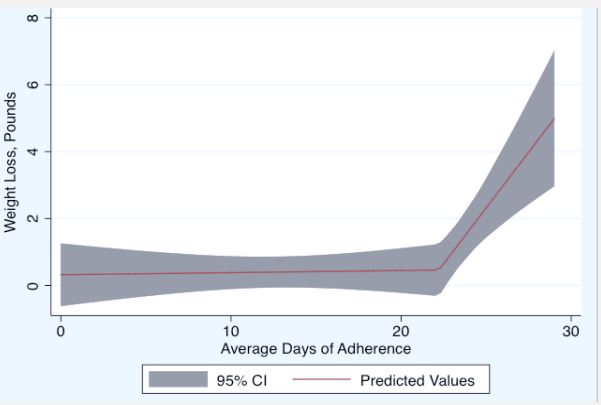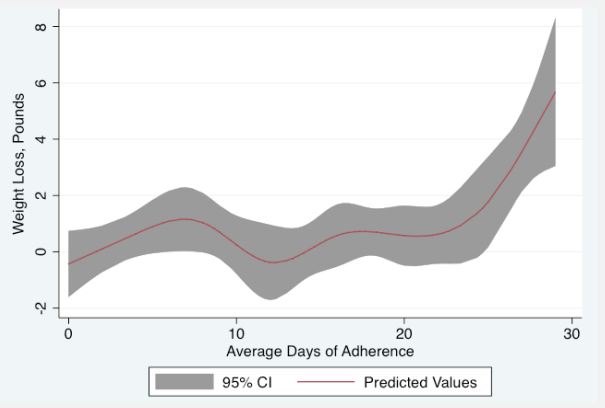Short Commentary
Volume 3, Issue 2
Adherence to Diet Advice Accelerates Weight Loss After 25 Days
Brian Wansink*
Retired, Dyson School of Applied Economics and Management, Cornell University, USA.
Corresponding Author :
Brian Wansink
Email: Wansink@Cornell.edu
Received : Jan 02, 2024 Accepted : Feb 07, 2024 Published : Feb 14, 2024 Archived : www.meddiscoveries.org
Citation: Wansink B. Adherence to Diet Advice Accelerates Weight Loss After 25 Days. Med Discoveries. 2024; 3(2): 1117.
Copyright: © 2024 Wansink B. This is an open access article distributed under the Creative Commons Attribution License, which permits unrestricted use, distribution, and reproduction in any medium, provided the original work is properly cited.
Abstract
Objective: To determine the relationship between the number of days of adherence to weight loss advice and actual weight loss.
Methods: Weight loss tips were randomly assigned within broad categories to participants. Number of days of adherence and weight loss were then recorded. Tips were distributed through a popular weight loss related website. Participants were visitors to this website. The sample consists primarily of adult females, with a total of 180 participants. After answering some questions about their goals, individuals were assigned three tips to healthier eating habits. Follow-up surveys were administered at the end of each month thereafter.
Results: Weight loss per day of adherence increases significantly after the 25th day of adherence. A day of adherence after the 25th day is more than 10 times more effective, resulting in nearly 0.5 pounds of weight loss as opposed to 0.04 pounds per day prior to the 25th day.
Conclusion: Our results demonstrate the importance of long-lasting adherence in achieving weight loss. Given the nature of the weight loss tips involved, our results suggest that ease of adherence may be one of the most important factors in administering health advice to those wishing to lose weight.
Keywords: Weight loss; Overweight and obesity; Medication adherence; Dieting; Behavioral sciences; Nutrition and dietetics.
Introduction
Between 2007 and 2008, 68.0% of adults in the United States were either overweight or obese [1]. Roughly a third of all Americans [2,3] are trying to lose weight. With Medicare recently approving doctors, nurses, and physicians’ assistants to help with weight loss programs, critical questions have been raised as to what type of advice could have the biggest influence.
Although stricter adherence to diet recommendations is positively associated with greater weight loss [4,7], it is unclear if a generalizable relationship between adherence and weightloss exists and if it does, what the nature of that relationship would be in the short run. Our primary interest is exploring the duration of adherence necessary for effective weight loss. We analyze data collected from dieters (n=394) who were randomly assigned three weight-loss tips per month on the website www. mindlesseating.org [8,9]. We find that the relationship between average duration of adherence and weight loss is positive and increases significantly around 25 days.
Methods
After obtaining IRB approval, data were collected from participants who volunteered to receive diet tips from www.mindlesseating.org [8-12]. Participants could choose one of four goals: 1) lose or maintain weight, 2) eat healthier, 3) eat more, or 4) help family eat better. An overwhelming majority (90.8%) had the objective to lose or maintain weight [2,13]. Participants were randomly assigned three tips each month that were relevant to their chosen goal. Examples of tips include— “Do not snack in front of television”, “Use an appetizer plate for a main dish at dinner”, “Eat the healthy items on the plate first”, and “Drink eight cups of water a day”. Each month participants self-reported the number of days they adhered to the tips and their weight in pounds. We exclude observations with monthly weight changes of 10 pounds or more to eliminate incorrectly entered reports or those from individuals with results too extreme for the nature of the tips received. This exclusion eliminates 4.8% of recorded observations. After these exclusions, the sample consists of 394 individuals (96.4% female) and 780 observations. The average BMI of participants is 28.1 and average weight is 170.1 lbs. Duration of participation was voluntary (up to 11 months), and in order to allow within subject controls we eliminate all who participated for less than 2 months (54.3%). Participants reported adhering to each tip an average of 13.6 days per month and reported losing an average of 0.94 pounds per month.
To determine the relationship between adherence and weight loss, we group the data by 5-day intervals of average adherence and examine how weight loss differed between these groups. We also use Generalized Least Squares (GLS) regression specifications with various controls (including initial weight, gender fixed effects, race fixed effects, and controls for the specific tips assigned). Next, we use a non-linear least squares routine to identify the location of a kink point in the relationship (linear spline). Finally, we fit the data with piece-wise thirdorder polynomials in a random effects model (cubic spline). The purpose in including this cubic spline is to determine whether a less restrictive model yields results similar to those suggested by the interval and linear spline identification strategies.
Results
Figure 1 displays average weight loss for participants in 5-day intervals. Those in a given month that adhere 25 or more days lose a disproportionately large amount of weight—an average of 1.98 pounds compared to the 0.76 pounds for those that averaged 20-24 days of adherence. Table 1 displays corresponding results from random effects regression. Column 1 of Table 1 shows the simple relationship of each interval relative to 0-4 days of adherence, controlling for the selected goal. In this specification, those that adhere 25 or more days lose an estimated 1.95 pounds more than those with 0-4 days of adherence, while those who adhere 20-24 days lose a significantly smaller 0.80 pounds (p<0.01). These results hold with varying levels of precision when we control for demographic variables (Column 2), or specific weight loss tips (Column 3).
Figure 2 displays the results of a linear spline allowing for the possibility of a discontinuity in the impact of adherence. This analysis identifies 24.55 days as the point where adherence becomes more effective. Table 2 displays regression results allowing for a differential effect of adherence beyond 25 days. The marginal coefficients represent the additional impact of each day of adherence after the split point beyond the baseline adherence. In the specification controlling only for goals (Column 1), each day after the break point is associated with an additional 0.35 pounds of weight loss (p=.05). This is a sizable increase given that an additional day of adherence is associated with only 0.06 pounds of weight loss for the first 24.55 days. Including additional controls yields similar, albeit less precise, results. Figure 3 displays the results of the much more flexible cubic spline regression. Despite the flexibility, the relationship in Figure 3 is remarkably similar to the relationship formed by the linear spline, with an apparent kink near the 25 day mark. (Although a cubic spline was used, a similar pattern is found using other flexible forms such as a lowess smooth plot).
One may ask if this result is driven by more individuals losing weight or individuals losing more weight after the 25th day. Of those adhering more than 25 days, no participants gained weight. Alternatively, for those adhering 20 to 24 days, almost 30% gained weight, with at least 15% gaining weight for each other category of adherence. Individuals who adhere 25 or more days are much less likely to gain weight than any other group.
Discussion
Our findings suggest that the impact of adherence on weight-loss and diet success significantly increases after 25 days of average adherence regardless of what advice is given. One limitation of this study is that adherence and weight are both selfreported [14]. If misreporting weight-loss and adherence are positively correlated then our results may overestimate the relationship between adherence and weight-loss. Additionally, participants only report adherence once a month, potentially reducing the accuracy of the reports.
In spite of these limitations, we believe this study reveals an important relationship between adherence and weight loss. There is greater benefit to adhering to a diet past 25 days a month, regardless of the type of diet. This information could prove useful to dieters and the health professionals who advise them.
Acknowledgements: The author declare no conflict of interest and the study received no financial support. All data were collected in accordance with Cornell University’s Institutional Review Board. Gratitude and respect to David R. Just and Richard Patterson for assistance with earlier versions of this article and its analyses.
References
- Flegal KM, Carroll MD, Ogden CL, Curtin LR. Prevalence and Trends in Obesity Among US Adults, 1999-2008. JAMA: The Journal of the American Medical Association. 2010; 303(3): 235-241.
- Wharton S, Lau DC, Vallis M, Sharma AM, Biertho L, CampbellScherer D, Adamo K, Alberga A, Bell R, Boulé N, Boyling E. Obesity in adults: a clinical practice guideline. Cmaj. 2020; 192(31): E875-91.
- Hu K, Staiano AE. Trends in obesity prevalence among children and adolescents aged 2 to 19 years in the US from 2011 to 2020. JAMA pediatrics. 2022; 176(10): 1037-9.
- Alhassan S, Kim S, Bersamin A, King AC, Gardner CD. Dietary adherence and weight loss success among overweight women: results from the A TO Z weight loss study. Int J Obes. 2008;32(6):985-991.
- Kruger J, Galuska DA, Serdula MK, Jones DA. Attempting to lose weight: Specific practices among U.S. adults. American Journal of Preventive Medicine. 2004; 26(5): 402-406.
- Gibson AA, Sainsbury A. Strategies to improve adherence to dietary weight loss interventions in research and real-world settings. Behavioral Sciences. 2017; 7(3): 44.
- Williamson D, Anton S, Han H, et al. Early behavioral adherence predicts short and long-term weight loss in the POUNDS LOST study. Journal of Behavioral Medicine. 2010; 33(4): 305-314.
- Wansink B, Just DR, Payne CR, Wansink B, Just DR, Payne CR. Mindless Eating and Healthy Heuristics for the Irrational. American Economic Review. 2009; 99(2): 165-169.
- Wansink B, Sobal J. Mindless eating: The 200 daily food decisions we overlook. Environment and Behavior. 2007; 39(1): 106-23.
- Kristeller JL, Epel E. Mindful eating and mindless eating: The science and the practice. The Wiley Blackwell handbook of mindfulness. 2014; 913-33.
- Wansink B. Slim by design: Mindless eating solutions for everyday life. Hay House, Inc.2016.
- Wansink B. From mindless eating to mindlessly eating better. Physiology & behavior. 2010; 100(5): 454-63.
- Serdula MK, Mokdad AH, Williamson DF, Galuska DA, Mendlein JM, Heath GW. Prevalence of Attempting Weight Loss and Strategies for Controlling Weight. JAMA: The Journal of the American Medical Association. 1999; 282(14): 1353-1358.
- Patterson, RW, Payne CR, Wansink B. “Decoupling the Independent Effects of Multiple Simultaneous Behaviors Changes in Weight Loss,” FASEB Journal. 2011; 25: 245.4.





